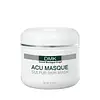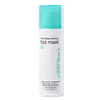What's inside
What's inside
 Key Ingredients
Key Ingredients

 Benefits
Benefits

 Concerns
Concerns

 Ingredients Side-by-side
Ingredients Side-by-side

Water
Skin ConditioningDisiloxane
Skin ConditioningSulfur
AntiseborrhoeicCocamidopropyl Betaine
CleansingKaolin
AbrasiveGlycerin
HumectantPyrus Malus Fruit Extract
Skin ConditioningDisodium Cocoyl Glutamate
CleansingAcacia Senegal Gum
MaskingPolyacrylate-33
Hectorite
AbsorbentButylene Glycol
HumectantZingiber Officinale Root Oil
MaskingQuartz
AbrasiveLecithin
EmollientCaprylic/Capric Triglyceride
MaskingTocopherol
AntioxidantRosmarinus Officinalis Leaf Oil
MaskingCurcuma Longa Root Extract
MaskingEucalyptus Globulus Leaf Oil
PerfumingCitrus Reticulata Leaf Oil
MaskingThymus Vulgaris Leaf Oil
AntimicrobialSalvia Sclarea Oil
MaskingMentha Viridis Leaf Oil
AstringentMentha Piperita Oil
MaskingLavandula Angustifolia Oil
MaskingAbies Sibirica Oil
MaskingAniba Rosaeodora Wood Oil
AstringentCymbopogon Nardus Oil
MaskingMelaleuca Alternifolia Leaf Oil
AntioxidantSodium Cocoyl Threoninate
CleansingXanthan Gum
EmulsifyingMicrocrystalline Cellulose
AbsorbentSodium Cocoyl Glutamate
CleansingSodium Citrate
BufferingPentylene Glycol
Skin ConditioningSodium Hydroxide
BufferingEthylhexylglycerin
Skin ConditioningCaprylyl Glycol
EmollientTetrasodium Glutamate Diacetate
Phenoxyethanol
PreservativeWater, Disiloxane, Sulfur, Cocamidopropyl Betaine, Kaolin, Glycerin, Pyrus Malus Fruit Extract, Disodium Cocoyl Glutamate, Acacia Senegal Gum, Polyacrylate-33, Hectorite, Butylene Glycol, Zingiber Officinale Root Oil, Quartz, Lecithin, Caprylic/Capric Triglyceride, Tocopherol, Rosmarinus Officinalis Leaf Oil, Curcuma Longa Root Extract, Eucalyptus Globulus Leaf Oil, Citrus Reticulata Leaf Oil, Thymus Vulgaris Leaf Oil, Salvia Sclarea Oil, Mentha Viridis Leaf Oil, Mentha Piperita Oil, Lavandula Angustifolia Oil, Abies Sibirica Oil, Aniba Rosaeodora Wood Oil, Cymbopogon Nardus Oil, Melaleuca Alternifolia Leaf Oil, Sodium Cocoyl Threoninate, Xanthan Gum, Microcrystalline Cellulose, Sodium Cocoyl Glutamate, Sodium Citrate, Pentylene Glycol, Sodium Hydroxide, Ethylhexylglycerin, Caprylyl Glycol, Tetrasodium Glutamate Diacetate, Phenoxyethanol
Ingredients Explained
These ingredients are found in both products.
Ingredients higher up in an ingredient list are typically present in a larger amount.
Butylene Glycol (or BG) is used within cosmetic products for a few different reasons:
Overall, Butylene Glycol is a safe and well-rounded ingredient that works well with other ingredients.
Though this ingredient works well with most skin types, some people with sensitive skin may experience a reaction such as allergic rashes, closed comedones, or itchiness.
Learn more about Butylene GlycolCaprylyl Glycol is a humectant and emollient, meaning it attracts and preserves moisture.
It is a common ingredient in many products, especially those designed to hydrate skin. The primary benefits are retaining moisture, skin softening, and promoting a healthy skin barrier.
Though Caprylyl Glycol is an alcohol derived from fatty acids, it is not the kind that can dry out skin.
This ingredient is also used as a preservative to extend the life of products. It has slight antimicrobial properties.
Learn more about Caprylyl GlycolThis oil is derived from the leaves of Eucalyptus Globulus, a type of Eucalyptus tree native to Australia.
Though this oil shows antibacterial and antioxidant activity, it is also a known skin-irritant due to its fragrance components.
Glycerin is already naturally found in your skin. It helps moisturize and protect your skin.
A study from 2016 found glycerin to be more effective as a humectant than AHAs and hyaluronic acid.
As a humectant, it helps the skin stay hydrated by pulling moisture to your skin. The low molecular weight of glycerin allows it to pull moisture into the deeper layers of your skin.
Hydrated skin improves your skin barrier; Your skin barrier helps protect against irritants and bacteria.
Glycerin has also been found to have antimicrobial and antiviral properties. Due to these properties, glycerin is often used in wound and burn treatments.
In cosmetics, glycerin is usually derived from plants such as soybean or palm. However, it can also be sourced from animals, such as tallow or animal fat.
This ingredient is organic, colorless, odorless, and non-toxic.
Glycerin is the name for this ingredient in American English. British English uses Glycerol/Glycerine.
Learn more about GlycerinKaolin is a clay. It is used for oil control and to help minimize pores. Like other clays, kaolin has the ability to absorb excess sebum or oil. This can help clean out pores and mattify the skin.
Some types of kaolin may have exfoliating properties. When water is added to kaolin, it becomes a paste with small abrasive particles.
Most kaolin is a white color, but may be pink/orange/red depending on where it comes from.
The name 'kaolin' comes from a Chinese village named 'Gaoling'. Kaolin clay comes from rocks rich in kaolinite. Kaolinite, the mineral, has a silicate layered structure. Kaolinite is formed from chemical weathering of aluminum siilicate minerals.
Besides skincare, kaolin is commonly used to make glossy paper, in ceramics, toothpaste, and as medicine to soothe stomach issues.
Learn more about KaolinSulfur is a commonly occurring element on Earth (and our universe!). In cosmetics, it helps kill bacteria, reduces sebum, and provides exfoliation. This makes it an effective ingredient to reduce breakouts and fight acne.
As a ketayolytic agent, it breaks down the top layer of skin. This is a form of exfoliation and may help decrease acne and hyperpigmentation.
Studies show sulfur has antibacterial and antifungal properties. Sulfur can be drying if used excessively or at higher concentrations. We recommend speaking with a medical professional if you have any concerns.
Ancient Greece, India, China, and Egypt have used sulfur in both traditional medicines and for household use.
Learn more about SulfurWater. It's the most common cosmetic ingredient of all. You'll usually see it at the top of ingredient lists, meaning that it makes up the largest part of the product.
So why is it so popular? Water most often acts as a solvent - this means that it helps dissolve other ingredients into the formulation.
You'll also recognize water as that liquid we all need to stay alive. If you see this, drink a glass of water. Stay hydrated!
Learn more about Water